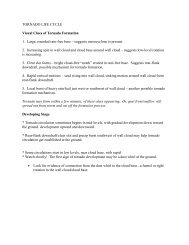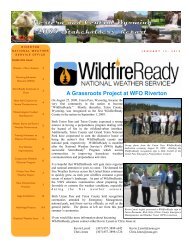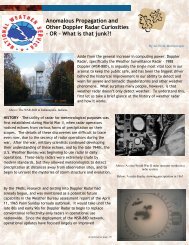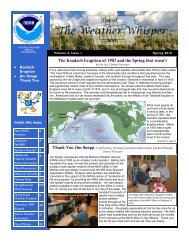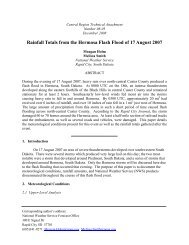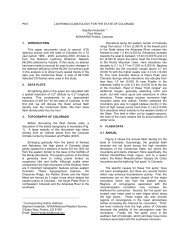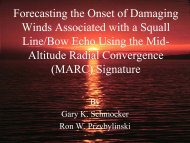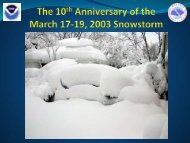The U.P. Weather Update - Central Region Headquarters - NOAA
The U.P. Weather Update - Central Region Headquarters - NOAA
The U.P. Weather Update - Central Region Headquarters - NOAA
You also want an ePaper? Increase the reach of your titles
YUMPU automatically turns print PDFs into web optimized ePapers that Google loves.
<strong>The</strong> U.P. <strong>Weather</strong> <strong>Update</strong><br />
Volume 4, Issue 2<br />
Inside this issue:<br />
Lake Superior water level 1<br />
Marine Web Portal 2<br />
New snow depth map 2<br />
Open House a success! 3,4<br />
Forecasting “Down Under” 5<br />
U.P. Drought 6,7<br />
November 2007<br />
Lake Superior water level rebounds in<br />
October, but remains below average.<br />
by David Pearson<br />
<strong>The</strong> current water level in Lake Superior is below the long term average. In fact,<br />
with the exception of a few near average months, Lake Superior has been below its<br />
long term average since 1998 (see graph below). Just when it seemed this trend<br />
would never end, the month of October brought substantial rains to the Lake Superior<br />
watershed. In total, the Lake Superior watershed saw over 4.5 inches of rain<br />
which is 1.9 inches above average for October. This rainfall, in combination with<br />
above average rainfall for September, caused Lake Superior to rise 8 inches from<br />
September 1st to October 31st. While this rise in water level is extremely beneficial<br />
to Lake Superior, the lake level remains a foot below its long term average.<br />
Employee News 7<br />
Sleeper Lake Fire 8<br />
<strong>Weather</strong> radio update 9<br />
<strong>The</strong> Last Word 9<br />
Graph courtesy of US Army Corp of Engineers<br />
Over the years, Lake Superior has seen its ups and downs, with this year being overall<br />
“down.” Since Lake Superior water levels started being recorded, the “Great<br />
Lake” has seen its fair share of above and below normal water levels. From 1928 to<br />
1953, with the exception of a few slightly below normal episodes, Lake Superior was<br />
above average. <strong>The</strong>n in 1955, like the flip of a switch, water levels began to decline<br />
and remained below normal through 1968. <strong>The</strong> weather of the 70s and 80s brought<br />
Lake Superior back above normal. In fact, the years 1985 and 1986 hold 10 of the 12<br />
monthly maximum water level records. <strong>The</strong> 90s saw a mixed bag of below and above<br />
normal activity. In 1998 Lake Superior went below normal and has stayed there<br />
since. If the historical water level for Lake Superior teaches us anything, it is that<br />
the lake will someday be above normal; the question is, when this will happen? <strong>The</strong><br />
latest forecast from the Army Corp of Engineers has the lake dropping 2 inches over<br />
the next month.<br />
For the latest forecast for Lake Superior and the other Great Lakes go to:<br />
http://www.lre.usace.army.mil/greatlakes/hh/greatlakeswaterlevels/waterlevelforecas<br />
ts/weeklygreatlakeswaterlevels/<br />
For the complete water level graphic for Lake Superior go here:<br />
http://www.lre.usace.army.mil/greatlakes/hh/datalinks/PrinterFriendly/quickGraph.pdf
VOLUME 4, ISSUE 2<br />
THE U.P. WEATHER UPDATE<br />
PAGE 2<br />
New Great Lakes Forecast page launched!<br />
by David Pearson<br />
On November 10th, 2007, the National <strong>Weather</strong> Service launched a new interactive way to view forecasts for the<br />
Great Lakes. <strong>The</strong> “Great Lakes Marine Web Portal” allows anyone with internet access to view graphical forecasts<br />
which include: wave height, wave period, wind speed, wind gusts, weather and temperature. In addition, you can also<br />
view current weather observations, water temperature profiles, current marine forecasts and water level forecasts.<br />
<strong>The</strong> Great Lakes Web Portal also provides many educational<br />
and safety materials about the Great Lakes.<br />
Please visit the new Great Lakes forecast page and let<br />
us know what you think.<br />
www.weather.gov/greatlakes/<br />
NWS Marquette launches new snow depth website<br />
by Tom Green<br />
Users of the NWS Marquette snow depth webpage will find a newly designed page when visiting the website this<br />
winter. New images will be used on the website that are generated by the National Operational Hydrologic Remote<br />
Sensing Center (NOHRSC) in Chanhassen, MN. NOHRSC generates graphics for the entire United States, including<br />
observed snowfall, snow depth, and snow water equivalent, using both ground and satellite observations. <strong>The</strong> snow<br />
depth webpage will provide a map of the entire Upper Peninsula, with zoomed in maps available by clicking on a portion<br />
of the area map. We welcome any questions, comments, or suggestions that users may have in regards to the<br />
snow cover webpage, or any other portion of the NWS Marquette webpage. To view the snow depth webpage, click on<br />
the “Current Snow Depth” link on the blue banner on the left side of our homepage, highlighted in the graphic bottom<br />
left. An example of the webpage is shown on the bottom right.
VOLUME 4, ISSUE 2<br />
NWS Marquette holds Open House<br />
THE U.P. WEATHER UPDATE<br />
by Marcia Cronce<br />
PAGE 3<br />
<strong>The</strong> National <strong>Weather</strong> Service office in Marquette held an Open House on Saturday, August 25 th . This was the second<br />
Open House the office has held since it was established at its current location, Negaunee Township, in 1996.<br />
<strong>The</strong> Open House proved to be a grand success, with over 300 people in attendance! Tours of the facilities commenced<br />
every half hour and included an introductory presentation about the history and function of our office, a<br />
tour of the operations area, complete with an explanation of the “Anatomy of a Warning”, and then a tour of the observing<br />
equipment outside. Outside, there were various hands-on weather activities, including a tornado machine,<br />
rain gage experiment, maximum/minimum temperature sensor, wind generator, interactive river model, weather<br />
safety miniature golf , weather balloon display, and a three-dimensional scaled snowfall climatology display. <strong>The</strong>re<br />
was also a weather forecasting contest and the winner got to job-shadow a forecaster for a day.<br />
In addition to the many exhibits, some of our cooperative observers (pictured below), volunteers who take rain, snow<br />
and temperature observations every 12 and 24 hours, were recognized for their efforts with an awards ceremony<br />
and refreshments.<br />
Pictured from left to right: David Petrovich (Observation Program<br />
Leader), Herman Kinnunen (Cooperative Observer) and<br />
Marvin Taulbee (former NWS Marquette employee).<br />
Mr. Kinnunen was awarded the 10 year service award for his<br />
work in taking daily weather observations in Baraga County.<br />
We appreciate all of observations our cooperative<br />
observers give us on a daily basis. Without<br />
your hard work, our jobs would not be possible.<br />
Thank you,<br />
Pictured left to right: Robin Turner<br />
(Meteorologist-In-Charge), Allan Slye<br />
(Cooperative Observer) and David Petrovich<br />
(Observation Program Leader).<br />
Mr. Slye was awarded the 25 year service<br />
award for his work in taking daily weather<br />
NWS Marquette Staff
VOLUME 4, ISSUE 2<br />
Pictures from the Open House!<br />
THE U.P. WEATHER UPDATE<br />
PAGE 4<br />
Forecaster Dave Guenther (far right), teaches a<br />
group about weather balloons.<br />
Kids playing at miniature golf weather safety display<br />
(Most of) <strong>The</strong> WFO Marquette Staff<br />
Forecaster Jason Alumbaugh (bottom left), shows<br />
a tour group the “Anatomy of a Warning”<br />
Thank you to all those who came to the Open House, we enjoyed spending part of the day with you!
VOLUME 4, ISSUE 2<br />
THE U.P. WEATHER UPDATE<br />
Kari Fleegel travels to Australia to forecast fires<br />
by Kari Fleegel<br />
In early 2007, over a dozen National <strong>Weather</strong> Service meteorologists assisted on the international scene. Anticipating<br />
a weak to moderate El Nino, which tends to bring dry weather to the Southwest Pacific, and an already dry<br />
spring, the Australian Bureau of Meteorology requested help from the United States.<br />
PAGE 5<br />
It is not unusual to have firefighters<br />
travel to different countries to assist<br />
with ongoing wildfires. In fact, Canadian<br />
and Australian forces can<br />
frequently be found on some of our<br />
US fires. However, meteorological<br />
assistance for fires is very rare.<br />
Between January and April, National<br />
<strong>Weather</strong> Service meteorologists<br />
were stationed at 3 of the 7 Bureau<br />
of Meteorology regional forecast<br />
centers in Sydney, Melbourne, and<br />
Hobart.<br />
I (pictured far right) was lucky<br />
enough to be chosen as one of these<br />
meteorologists, and was stationed in<br />
Hobart from mid March to early<br />
April. <strong>Weather</strong> is very universal, but<br />
some training was still necessary in order for us to give adequate support to fire personnel. As a result, the first two<br />
days of my dispatch were spent at the training center in Melbourne. From there I travelled to Hobart. Even though<br />
fires were winding down at the time of my deployment, there were still some active burns going on. During this<br />
time, I produced the daily fire weather forecasts, spoke to fire personnel and gave them site specific forecasts for<br />
ongoing or planned burns.<br />
Three different National <strong>Weather</strong> Service meteorologists spent time at the Hobart office. <strong>The</strong> other two were from<br />
Kansas and Colorado. It was a great experience to learn about different forecasting methodologies to foster relationships<br />
between groups of people who have one very important thing in common, the love of weather.<br />
Due to Australia’s location in the southern hemisphere, the peak fire season is during their summer months of December<br />
through February. <strong>The</strong> fire season started early in Hobart, Tasmania, the island state of Australia just<br />
south of the mainland. <strong>The</strong> above picture, courtesy of Ian Stewart, is of a large fire that got dangerously close to the<br />
town of Hobart, scorching many of the surrounding hills in October 2006.
VOLUME 4, ISSUE 2<br />
THE U.P. WEATHER UPDATE<br />
PAGE 6<br />
La Nina forecasted to develop over the next three months<br />
by Kevin Crupi and David Pearson<br />
<strong>The</strong> Climate Prediction Center (CPC) is forecasting a slightly greater than climatological chance of an above normal<br />
average temperature for the next three months (December 2007 through February 2008). In addition , CPC is<br />
also predicting a greater than climatological chance of precipitation over south central and eastern Upper Michigan,<br />
but an equal chance of above and below normal precipitation over the west and north central. Water temperatures<br />
in the tropical eastern Pacific Ocean have dropped to between 1 and 3 degrees below normal, which translates<br />
to a La Nina. This temperature shift is forecast to persist through the winter. Similar La Nina conditions<br />
prevailed during 1995-1996 and 1998-1999. As you may recall, the winter of 1995-1996 was cold and snowy, while<br />
the winter of 1998-1999 was generally mild with below normal total snowfall. For the most current El Nino/La<br />
Nina forecast please go to: http://www.cpc.ncep.noaa.gov/products/precip/CWlink/MJO/enso.shtml <strong>The</strong> table below<br />
is a summary of the past six La Nina events that occurred and the corresponding average maximum/minimum<br />
temperatures, total snowfall and total precipitation for December, January and February of each episode at our<br />
office.<br />
Values valid for NWS Marquette office<br />
Years (DJF) Average Max<br />
Temperature<br />
Average Min<br />
Temperature<br />
Total<br />
Snowfall<br />
Total Melted<br />
Precipitation<br />
1983-1984 23.6 4.8 119 8.15<br />
1984-1985 23.0 5.2 140.1 8.65<br />
1995-1996 21.8 3.8 149.5 10.61<br />
1998-1999 26.2 10.7 130.1 9.68<br />
1999-2000 27.2 8.5 105.2 5.14<br />
2000-2001 22.6 7.9 175.5 7.82<br />
Average 24.9 8.4 120.9* 6.98* * = average value (1980 to 2007)<br />
Upper Michigan drought conditions improve!<br />
By Tom Green<br />
Upper Michigan has seen a great deal of variety in its drought status over the last 6 months. <strong>The</strong> entire<br />
area has suffered from below normal precipitation, both in the short- and long-term. As of May 1 st , the western half<br />
of Upper Michigan was categorized as abnormally dry by the U.S. Drought Monitor, while the eastern half was not<br />
included in any drought category. By the middle of July, the western third was classified in a severe drought, with<br />
much of the eastern U.P. under a moderate drought.<br />
<strong>The</strong> drought status continued to worsen into early September, as many sites reported rainfall well below<br />
normal. Many sites reported approximately half of their normal rainfall for the May through August period, with<br />
the effects intensified by above average temperatures through the time period. Newberry, the city of Marquette,<br />
and the NWS Marquette office in Negaunee Township all reported their lowest May to August rainfall on record,<br />
with the Houghton County Airport, Iron Mountain, Ontonagon, Munising, and Ironwood all recording one of the 5<br />
driest May to August periods on record. Over the 12 month period from September 2006 to August 2007, the<br />
Houghton County Airport was almost 12 inches below normal, only receiving 65 percent of the average precipitation.<br />
<strong>The</strong> U.S. Drought Monitor reported extreme drought conditions north of a line from Ironwood to Escanaba<br />
over to Grand Marais, with the rest of Upper Michigan experiencing severe drought conditions.<br />
<strong>The</strong> rains finally arrived to the Upper Peninsula in September. Several soaking rainfalls moved across the<br />
area, bringing over 5 inches of rain to some locations in the first week of the month alone. <strong>The</strong> NWS Marquette office<br />
set its single day record rainfall, receiving 4.29 inches of rain on September 4 th . <strong>The</strong> office received a total of<br />
7.48 inches of precipitation for the month, just short of the all time monthly September record of 7.60 inches set in<br />
1968. <strong>The</strong> Houghton County Airport received 11.24 inches of precipitation, shattering the previous September record<br />
of 6.62 inches and previous monthly record of 9.48 inches. In the first 8 months of the year, the airport had<br />
only received 13.5 inches of precipitation.<br />
<strong>The</strong> October 4 th issuance of the U.S. Drought Monitor showed the improvement in drought conditions.<br />
South <strong>Central</strong> Upper Michigan remained under severe drought conditions, mainly as a result of the September<br />
storms staying north of that region. <strong>The</strong> rest of Upper Michigan was classified in the moderate drought category.<br />
(continued on next page)
VOLUME 4, ISSUE 2<br />
THE U.P. WEATHER UPDATE<br />
PAGE 7<br />
Drought conditions improve!<br />
by Tom Green<br />
Drought conditions continue to improve across Upper Michigan.<br />
As of November 15, south central Upper Michigan was classified<br />
under moderate drought conditions, while the rest of Upper<br />
Michigan was classified as abnormally dry. While the above<br />
normal rainfall has essentially eliminated the short-term<br />
drought concerns, the region remains several inches below normal<br />
over the last few years. As a result, the area will likely<br />
remain under abnormally dry conditions until several months of<br />
above normal precipitation eliminates the long-term deficit.<br />
For the latest drought monitor map, check out:<br />
www.drought.unl.edu/dm/monitor.html<br />
Images courtesy of U.S. Drought Monitor<br />
Employee News<br />
by Tom Green<br />
Since the last published newsletter, two employees have transferred to different locations. In September of 2007,<br />
Intern Meteorologist Jennifer Lee was promoted to a General Forecaster position in Huntsville, AL. In October of<br />
2007, Tom Hultquist, Science and Operations Officer, transferred to the Twin Cities office in Chanhassen, MN,<br />
where he assumed a similar position to the one he held at this office. Both Tom and Jennifer provided great contributions<br />
to the Marquette office, both in terms of internal training and development and outreach programs such as<br />
the Open House and Cooperative Observer programs.<br />
Jennifer’s position in the office will be filled by Steve Fleegel, who will transfer from the Green Bay NWS office.<br />
Steve is originally from Minnesota and graduated from UND with his bachelor’s degree in Meteorology. He is the<br />
husband of General Forecaster Kari Fleegel. Steve arrived on station the week after Thanksgiving.<br />
Tom’s position, Science and Operations Officer, will be filled by Michael Dutter. Mike is transferring from the NWS<br />
office in Cleveland, OH where he is a lead forecaster. Mike is no stranger to Michigan’s Upper Peninsula; from 2001<br />
to 2004, Mike was a General Forecaster at the NWS office in Marquette. Mike is scheduled to arrive on station during<br />
the first week of the new year.<br />
Did you know the National <strong>Weather</strong> Service spans across 12 time zones?<br />
<strong>The</strong>re are NWS offices:<br />
• as far west as Koror, Micronesia (7,904 miles away) - near the Philippines<br />
• as far north as Barrow, Alaska (2,767 miles away)<br />
• as far south as Pago Pago, American Samoa (7,461 miles away)<br />
• as far east as U.S. Virgin Islands (2,306 miles away)
VOLUME 4, ISSUE 2<br />
THE U.P. WEATHER UPDATE<br />
Forecasting at the Sleeper Lake Fire<br />
PAGE 8<br />
By Kari Fleegel<br />
Other than our regular Fire <strong>Weather</strong> Planning Forecast and Point Forecasts, a special service was implemented for<br />
the Sleeper Lake Fire. This was the use of an IMET. It is rare to utilize this resource for the state of Michigan. In<br />
fact, it has been well over 15 years since an IMET has been utilized. For comparison, the state of Minnesota deploys<br />
1 to 2 IMETs a year on various fires.<br />
So you are asking, what is an IMET? Well, an IMET is an Incident Meteorologist. In the National <strong>Weather</strong> Service,<br />
we have 77 specialized personnel that train for fire and other deployments. In the past, these other deployments<br />
have included fires, as well as various events of social significance and danger, such as Hurricane Katrina, the space<br />
shuttle Columbia recovery efforts, and the Greensburg, Kansas tornado.<br />
For 2 weeks during the peak of the fire, August 10 th to the 23 rd , John Jacobson, IMET from the National <strong>Weather</strong><br />
Service office in Jackson, Kentucky joined the team on the Sleeper Lake fire. He was the life line between the Marquette<br />
National <strong>Weather</strong> Service office and fire personnel on the scene. His role included preparing daily site specific<br />
forecasts and attending various meetings where this information was discussed. He was an invaluable resource and<br />
the National <strong>Weather</strong> Service office in Marquette thanks him for his assistance during this large UP fire.<br />
In all, the Sleeper Lake fire burned more than 18,185 acres and cost over 7 million dollars. <strong>The</strong>se numbers could<br />
have been much higher if it wasn’t for the brave individuals who fought and managed the fire.<br />
Due to the remote location of the fire, aerial<br />
fire suppression had to be used to get to<br />
those hard-to-reach areas.<br />
Photos courtesy of Michigan DNR
VOLUME 4, ISSUE 2<br />
THE U.P. WEATHER UPDATE<br />
<strong>NOAA</strong> All Hazards <strong>Weather</strong> Radio is expanding!<br />
PAGE 9<br />
Two new <strong>NOAA</strong> <strong>Weather</strong> Radio transmitters are coming to the Upper Peninsula! <strong>The</strong> transmitter near Crystal Falls<br />
is expected to be online sometime this winter. <strong>The</strong> installation of the transmitter near Marenisco has encountered a<br />
few delays and should be up and running by late spring. <strong>The</strong> Marenisco transmitter will cover Gogebic and Ontonagon<br />
counties in Upper Michigan, and Iron and Vilas counties in Wisconsin. It will also distribute nearshore marine<br />
forecasts for the zones between Saxon Harbor and Ontonagon. <strong>The</strong> Crystal Falls transmitter will cover Iron,<br />
Dickinson and Baraga counties in Upper Michigan, and Forest and Florence counties in Wisconsin. Keep checking<br />
our website (http://weather.gov/mqt) for more information regarding the start dates and frequencies of these two new<br />
transmitters.<br />
<strong>The</strong>re is a new transmitter on air in Northern Lower Michigan, located near Good Hart, Michigan in northern Emmet<br />
County. It operates at a frequency of 162.475 MHz. <strong>The</strong> transmitter provides coverage across northeastern<br />
Lower Michigan, Mackinac County, the Straits of Mackinac, and northern Lake Michigan open lake and nearshore<br />
marine zones. <strong>The</strong> two pictures below show the <strong>NOAA</strong> weather radio coverage before the new transmitters are<br />
added and after. Notice that the large unshaded area across the western half of Upper Michigan is almost completely<br />
removed.<br />
Current weather radio coverage<br />
by Marica Cronce<br />
<strong>NOAA</strong> <strong>Weather</strong> Radio website<br />
Anticipated weather radio coverage<br />
(transmitters in Wisconsin, Chippewa<br />
County and Lower Michigan not pictured.)<br />
<strong>The</strong> Last Word<br />
by<br />
David Pearson<br />
Thank you for taking the time to read this newsletter, I enjoyed putting it together. A big thank you to all those who<br />
attended our Open House back in August. We were happy to show you a glimpse of what goes on at this office. If<br />
you have any comments or future story ideas for this newsletter, feel free to email me at david.pearson@noaa.gov.




